Understanding consumer preferences is perhaps the biggest challenge for food manufacturers, but interpreting the parent-child dynamic requires even deeper insight – a focus that shapes the strategy at Kidfresh.
Companies like Kidfresh must not only navigate the growing demand for food safety and nutrition to satisfy caregivers, they are also charged with developing products that kids will actually eat.
“It is the dynamic of the whole family – the diversity and the makeup of a family these days is very significant, so we talk to everyone,” CEO Michael Allen said. “It could be a caregiver, an aunt, a grandparent, a partner – it could be anything, so whoever’s responsible that day, and in that scenario for providing a healthy meal for the child in the house, that’s who we talk to.”
Kidfresh, launched in 2007, produces a 15-SKU line of clean-label frozen kids’ meals, including chicken nuggets, fish sticks, pizza and more.
The privately-held company is growing rapidly – 25% year over year in a category that is down 5%, according to Allen – and can be found in some of the biggest retail grocery stores in the country, including Whole Foods, Target, Publix, H-E-B and Wegmans.
Kidfresh isn’t resting on its laurels, though.
Despite its nearly two-decades in the healthy kids’ meals business, Kidfresh, like its competitors, must stay on top of the latest trends. They plan to launch new products in April, but Allen is keeping a tight lid on the details.
Deconstructing the day
The psychology behind feeding kids can operate in broad brush strokes, but there’s a predictability to how many families manage their days.
Allen said mornings are about time management, while afternoons and early evenings are about hunger management.
In the morning, parents and caregivers are often in a rush to get kids off to school. “The parent’s concern is to get them something nutritious as quickly as possible, because we’re in a time crunch here,” he said.
Late afternoons and evenings are really more about bridging the hunger between lunch and dinner, according to Allen.
“So two or three meatballs at four o’clock in the afternoon for a five year old is a great snack,” he said. “It doesn’t need to be dinner. A snack doesn’t need to be a candy or a chip or a carbohydrate. It can be a protein, right?”
Protein for kids
It comes as no surprise that protein is a big selling point for kids’ meals, and plant-based protein options are growing rapidly.
“Where you get your protein is almost as important as how much, and depending on your age group and what you’re looking at for physical activity, some recommendations are as high as 100 grams of protein a day,” according to Allen.
The value of that protein is even more important with the rising cost of food, he said.
Allen highlighted the advantage of frozen meals in their ability to maintain shelf-stability.
“Once you freeze a product, it really locks in the nutrients so they don’t decay as fast as something sitting on your counter, where the nutrients start decaying essentially as soon as you bring it home from the store,” he said.
He says the protein trend is only getting bigger “and the ability to get high-efficacious, good quality protein will continue,” he said.
“I think that’s one thing that most individuals would agree, and the pediatric community would agree that you need to have protein, and the way in which you get it, obviously, is important.”
The growing freezer aisle
The frozen food section of the grocery store is changing and honing in on consumer preferences, and that includes frozen kids’ meals, according to Allen.
Perceptions of the frozen food aisle have changed over the last 20 years and what was once considered lower quality food is becoming increasingly known for healthier options at lower prices, he added.
Over the last decade, grocers have begun to organize frozen food sections differently and are increasingly creating kids’ food sections.
“I will tell you that five to 10 years ago, there really wasn’t a kids door or a kids destination,” he said.
That trend has grown alongside freezer doors focused on international cuisines.





